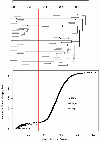Clustering-based identification of clonally-related immunoglobulin gene sequence sets
- PMID: 20875155
- PMCID: PMC2946782
- DOI: 10.1186/1745-7580-6-S1-S4
Clustering-based identification of clonally-related immunoglobulin gene sequence sets
Abstract
Background: Clonal expansion of B lymphocytes coupled with somatic mutation and antigen selection allow the mammalian humoral immune system to generate highly specific immunoglobulins (IG) or antibodies against invading bacteria, viruses and toxins. The availability of high-throughput DNA sequencing methods is providing new avenues for studying this clonal expansion and identifying the factors guiding the generation of antibodies. The identification of groups of rearranged immunoglobulin gene sequences descended from the same rearrangement (clonally-related sets) in very large sets of sequences is facilitated by the availability of immunoglobulin gene sequence alignment and partitioning software that can accurately predict component germline gene, but has required painstaking visual inspection and analysis of sequences.
Results: We have developed and implemented an algorithm for identifying sets of clonally-related sequences in large human immunoglobulin heavy chain gene variable region sequence sets. The program processes sequences that have been partitioned using iHMMune-align, and uses pairwise comparisons of CDR3 sequences and similarity in IGHV and IGHJ germline gene assignments to construct a distance matrix. Agglomerative hierarchical clustering is then used to identify likely groups of clonally-related sequences. The program is available for download from http://www.cse.unsw.edu.au/~ihmmune/ClonalRelate/ClonalRelate.zip.
Conclusions: The method was evaluated on several benchmark datasets and provided a more accurate and considerably faster identification of clonally-related immunoglobulin gene sequences than visual inspection by domain experts.
Figures
References
-
- Tabibian-Keissar H, Zuckerman NS, Barak M, Dunn-Walters DK, Steiman-Shimony A, Chowers Y, Ofek E, Rosenblatt K, Schiby G, Mehr R, Barshack I. B-cell clonal diversification and gut-lymph node trafficking in ulcerative colitis revealed using lineage tree analysis. Eur J Immunol. 2008;38:2600–2609. doi: 10.1002/eji.200838333. - DOI - PubMed
-
- Zuckerman NS, Howard WA, Bismuth J, Gibson K, Edelman H, Berrih-Aknin S, Dunn-Walters D, Mehr R. Ectopic GC in the thymus of myasthenia gravis patients show characteristics of normal GC. Eur J Immunol. 2010;40:1150–1161. - PubMed
-
- Manske MK, Zuckerman NS, Timm MM, Maiden S, Edelman H, Shahaf G, Barak M, Dispenzieri A, Gertz MA, Mehr R, Abraham RS. Quantitative analysis of clonal bone marrow CD19+ B cells: use of B cell lineage trees to delineate their role in the pathogenesis of light chain amyloidosis. Clin Immunol. 2006;120:106–120. doi: 10.1016/j.clim.2006.01.008. - DOI - PubMed
LinkOut - more resources
Full Text Sources
Other Literature Sources

